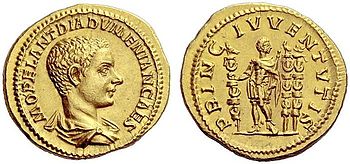Diadumenianus

Marcus Opellius Diadumenianus (short Diadumenian * September 14 208 ; † summer 218 ) was the son of Roman emperor Macrinus . After his father's elevation to emperor in April 217, he was given the title Caesar and the name Marcus Opellius Antoninus Diadumenianus . The following year Diadumenianus was nominally co-regent, but soon afterwards he died in the fall of his father.
Life
The father of Diadumenianus, the Praetorian prefect Macrinus, belonged to the knighthood . It was built by Emperor beginning 217 Caracalla in the senatorial levied and received the title clarissimus vir ( "highly respected man"). At the same time, Diadumenianus, who was not yet nine at the time, was accepted into the senatorial class; he is attested in inscriptions as clarissimus puer ("highly respected boy").
Macrinus organized the murder plot to which Emperor Caracalla fell victim on April 8, 217, and was then raised by the army to his successor. Soon after, he left his son in the city of Zeugma on the Euphrates to Caesar and proclaim to his future successor. Diadumenianus received the very popular emperor name Antoninus, which reminded of Marcus Aurelius and which Caracalla also carried.
On September 14, 217, chariot races were held in Rome on the occasion of Diadumenianus' birthday. There was a protest against Macrinus because of his continuing absence from the capital.
When the rebellion of Elagabal broke out in May 218 , whose followers passed him off as the illegitimate son of Caracalla, Macrinus, who was still in Syria, reacted in Apamea by elevating his son to Augustus , i.e. a nominally equal co-ruler. After his defeat by Elagabal in the decisive battle at Antiocheia on June 8, 218, Macrinus tried to flee to Rome, but was caught and killed. He had sent Diadumenianus to the Parthian King Artabanos IV in order to bring him to safety. But Diadumenianus was arrested while fleeing in Zeugma, where he was known from the Caesar proclamation, and soon afterwards killed. As is customary in such cases, the damnatio memoriae (erasure of memory) followed, which resulted in the destruction of the images of the ostracized and the erasure of his name on inscriptions and papyri .
In the late antique Historia Augusta Diadumenianus was given his own biography, which is embellished with invented information and whose source value is low.
iconography
The appearance of Diadumenianus is only known from coin and medallion minting. It is unlikely that any of the various round sculptures it has been considered for actually represent him. The coin portraits follow the early Severe tradition; they are reminiscent of the coin portraits of Caracallas from his time as Caesar .
literature
- Ronald Syme : The Son of the Emperor Macrinus . In: Phoenix Vol. 26, 1972, pp. 275-291
- Klaus-Peter Johne : M. Opellius Diadumenianus . In: Leiva Petersen (ed.): Prosopographia Imperii Romani , 2nd edition, part 5, de Gruyter, Berlin 1970–1987, pp. 442–445 (O 107)
iconography
- Max Wegner : Diadumenianus . In: Heinz Bernhard Wiggers , Max Wegner: Caracalla, Geta, Plautilla. Macrinus to Balbinus (= Max Wegner (Hrsg.): The Roman image of rulers , section 3, volume 1). Gebrüder Mann, Berlin 1971, ISBN 3-7861-2147-8 , pp. 141-145
Web links
- Donatien Grau: Technical short biography (French) from De Imperatoribus Romanis
- Biography from the Historia Augusta (English)
Remarks
- ↑ Cassius Dio 79 (78), 13.1; CIL XV 7505. When citing some of the books of Cassius Dio's work, different counts are used; a different book count is given here and below in brackets.
- ↑ CIL XV 7505.
- ^ Ronald Syme: The Son of the Emperor Macrinus . In: Phoenix 26, 1972, pp. 275-291, here: 277f .; Julia Sünskes Thompson: Uprisings and protest actions in the Imperium Romanum , Bonn 1990, p. 69f.
- ^ Cassius Dio 79 (78), 20. See Julia Sünskes Thompson: Uprising and protest actions in the Imperium Romanum , Bonn 1990, p. 36, 120–122.
- ^ Ronald Syme: The Son of the Emperor Macrinus . In: Phoenix 26, 1972, pp. 275-291, here: 277.
- ↑ Cassius Dio 79 (78), 40.1; Herodian 5,4,12. See Ronald Syme: The Son of the Emperor Macrinus . In: Phoenix 26, 1972, pp. 275-291, here: 278.
- ↑ To carry out this measure in the case of Diadumenianus, see Eric R. Varner: Mutilation and Transformation. Damnatio Memoriae and Roman Imperial Portraiture , Leiden 2004, pp. 185–188.
- ↑ Florian Leitmeir: Breaks in the portrait of the emperor from Caracalla to Severus Alexander . In: Stephan Faust, Florian Leitmeir (eds.): Forms of Representation in Severan Time , Berlin 2011, pp. 11–33, here: 19f .; Max Wegner : Diadumenianus . In: Max Wegner (Hrsg.): The Roman image of rulers , Department 3 Volume 1, Berlin 1971, pp. 141–145.
| personal data | |
|---|---|
| SURNAME | Diadumenianus |
| ALTERNATIVE NAMES | Diadumenianus, Marcus Opellius; Diadumenianus, Marcus Opellius Antoninus |
| BRIEF DESCRIPTION | Son of the Roman Emperor Macrinus |
| DATE OF BIRTH | September 14, 208 |
| DATE OF DEATH | 218 |
